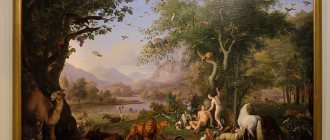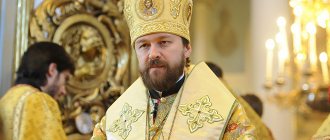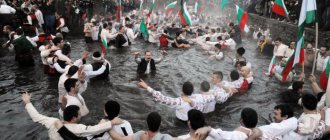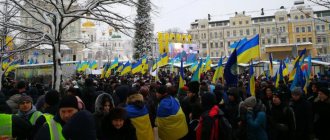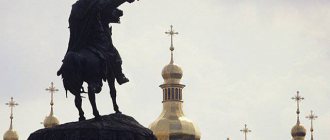The "RPC" request is redirected here; for other meanings, see ROC (meanings).
| Russian Orthodox Church | |
| church glory Russian Orthodox Church | |
| Cathedral Church of Christ the Savior, Moscow | |
| General information | |
| Founders | Apostle Andrew (according to church tradition) Patriarch Photius I of Constantinople (in the 860s he created the diocese of “Russia”[1]); Patriarch Nicholas II of Constantinople, who installed Michael as Metropolitan of Kyiv (988); Prince Vladimir Svyatoslavich |
| Base | 15 December 1448 |
| Confession | Orthodoxy[2] |
| Mother Church | Patriarchate of Constantinople |
| Autocephaly | de facto since 1448[3][4] de jure since 1589[3][5] |
| Recognition of autocephaly | recognized by all local Orthodox churches |
| Management | |
| Primate | Patriarch of Moscow and All Rus' Kirill |
| Center | As part of the Patriarchate of Constantinople : Kiev (X century - 1299); Vladimir (1299-1325; de facto); Moscow (1325-1448; de facto); Autocephaly : Moscow (1448-1721); St. Petersburg (1721-1917); Moscow (since 1917) |
| Cathedral | Cathedral Church of Christ the Savior |
| Primate's residence | Danilov Monastery, Moscow |
| Territories | |
| Jurisdiction (territory) | Russia Azerbaijan[note 1] Belarus [note 2] Kazakhstan[note 3] Kyrgyzstan[note 4] Latvia[note 5] Lithuania[note 6] Tajikistan[note 7] Turkmenistan[note 8] Uzbekistan[note 9] Japan[6] [note 10] China[7][8](disputed)[9][note 11] Moldova (disputed)[note 12] Mongolia[10](disputed) Ukraine (disputed)[11][12][13][ 14][note 13] Estonia (disputed)[15][note 14] Russian diaspora (partially)[note 15] |
| Dioceses outside jurisdiction | Western, Central and Northern Europe (Patriarchal Exarchate in Western Europe, Berlin and German Diocese, Budapest and Hungarian Diocese, Vienna and Austrian Diocese, Archdiocese of Western European Parishes of the Russian Tradition, Patriarchal Parishes in Norway, Patriarchal Parishes in Finland, Patriarchal Parishes in Sweden) America (Argentine and South American Diocese, Patriarchal Parishes in Canada, Patriarchal Parishes in the USA) East and Southeast Asia (Patriarchal Exarchate in Southeast Asia) Armenia (Patriarchal Parishes in Armenia) |
| Autonomous churches in canonical dependence | Chinese Latvian Moldavian Russian Orthodox Church Abroad Ukrainian Estonian Japanese |
| Divine service | |
| Ritual | Byzantine, Western rites |
| Liturgical language | Synodal translation of the Church Slavonic language, limited to the languages of the peoples of Russia, in foreign parishes also in local languages |
| Calendar | Julian[16] |
| Statistics | |
| Bishops | 382 (at the beginning of 2021)[17] |
| Dioceses | 314 (at the end of 2019)[18] |
| Monasteries | 972 (474 men and 498 women)[17] |
| Parishes | 38,649 “temples or other premises in which the Divine Liturgy is celebrated”[17] |
| Priests | 40,514 full-time clergy, including 35,677 presbyters and 4,837 deacons[17] |
| Monks and nuns | 5883 monks and 9687 nuns (including ryassophores) |
| Website | patriarchia.ru |
| Media files on Wikimedia Commons | |
| Quotes on Wikiquote | |
| Information on Wikidata? | |
Russian Orthodox Church
(
ROC
, another official name [comm. 1] -
Moscow Patriarchate
[21] (
MP
)) is the largest autocephalous local Orthodox Church in the world [22][23][24][25]. It occupies fifth place in the diptych of autocephalous local churches of the world[26][27]. The largest and most influential religious organization in Russia[25]. The largest religious organization is also in Ukraine (as of 2011 in terms of the number of parishes, clergy[28][29] and places of worship[30], but, according to some surveys at the beginning of 2015[31], not in terms of the number of believers), in Belarus, Moldova[32][33] (including Transnistria)[34].
Considers itself as the only canonically legitimate Orthodox administrative-independent church on the territory of the former Soviet Union, excluding Georgia (within the borders of the Georgian SSR[35]) and Armenia[note 16], recognized as the canonical territory of the Georgian Orthodox Church, as well as in Japan, China[ 36] and from February 2021 in Mongolia[37]; considers itself the only legitimate successor to the local Russian Orthodox Church[38], the Synodal Russian Church and the Kyiv Metropolis within the Patriarchate of Constantinople. In addition, according to its Charter, the jurisdiction of the Russian Orthodox Church “extends to Orthodox Christians who voluntarily join it and live in other countries”[39]. However, its exclusive jurisdiction in the PRC and Estonia[15] is disputed by the Patriarchate of Constantinople, on the territory of Ukraine - by the Orthodox Church of Ukraine[40][41], and in Moldova - by the Romanian Orthodox Church[9][note 17].
The name “Russian Orthodox Church” has been used for a long time[42], but was adopted as official only in the fall of 1943[38]. Previously, the names “Russian Orthodox Church”, “Greek-Eastern Russian Church” and others were used. The Russian Orthodox Church as a centralized organization until 1991 did not have the status of a legal entity[43], which it acquired in full on the territory of the RSFSR on May 30, 1991 when the Ministry of Justice of the RSFSR registered the Civil Charter of the Russian Orthodox Church[44] on the basis of the USSR Law of October 1, 1990 “On freedom of conscience and religious organizations.” Canonical units located on the territory of states other than the Russian Federation may be registered as independent legal entities under other names in accordance with the legislation in force in each country.
The religious and legal basis for its organization and activities is the Holy Scripture, as well as the Holy Tradition[45]. The latter includes the canons, liturgical texts authorized by the Church, the works of the Holy Fathers, the lives of the Saints, as well as the customs of the Church[46].
Content
- 1 Name of the church
- 2 History 2.1 Before 1917
- 2.2 During the years of Soviet power
- 2.3 1991—2018
- 2.4 After 2021: Severance of relations with other Orthodox Churches
- 3.1 Russian Empire
- 4.1 General information
- 6.1 Catholicism
Universality of the Catholic Faith
In the early years of the apostolic period, the “good confession” about which Paul wrote to Timothy (1 Tim. 6:12) was provided by instruction and teaching. Then, issues of church life and religion - such as the attitude towards Christians who apostatized during the period of persecution from the vows given at baptism, or towards baptism received from heretics, were collectively decided by representatives of different Churches in Rome, Antioch and Carthage. They also jointly condemned schismatics and heretics.
Immediately after Constantine's conversion, such "councils" or "synods" took place in the West with the participation of bishops representing an increasing number of local Churches. One of the most famous cathedrals of this kind was Arles in 314.
Then came the era of the Ecumenical Councils, which were also a response to the challenge of universality: they formulated statements common to the entire Church. Within the framework of this work, it is not possible to present the history of the Seven Ecumenical Councils, the definitions of which are recognized by almost all existing Christian denominations76. The problems of the Councils can be judged from textbooks devoted to issues of Trinitarian theology and Christology, since all Councils directly or indirectly dealt with the consideration and condemnation of heretical ideas about the divine and human natures in Christ and their hypostatic unity. These councils are called "ecumenical" in Greek, which indicates their universal significance, since the word "ecumene" means the entire inhabited world.
For the first time, the definition of “ecumenical” is found in the materials of the Council of Chalcedon in 451 in application to the meeting of bishops that took place in Nicaea in 325 - the “great and holy Council”77. In the message that the participating fathers sent to the Pope, St. Leo I the Great (440-461) and in which it is reported that the Council accepted the provisions put forward by it regarding the two natures and the unity of the personality (hypostasis) of Christ, this word is also present. In its “Definition of Faith” the Council described itself as “a great, holy and Ecumenical Council..., meeting in the metropolis of the province of Bithynia, Chalcedon”78.
Indeed, although in Nicaea the participating fathers were overwhelmingly representatives of the East, this Council can well be considered an Ecumenical Assembly of Bishops, for the West was also represented at it in the person of two legates of the Bishop of Rome. The anathematisms added by the Council to the Creed it adopted were pronounced on behalf of the “catholic and apostolic Church,” and it was the faith of the entire Church that St. defended at it from numerous opponents. Athanasius the Great (297-373).
The Council of Chalcedon confirmed the legitimacy of the Council of Constantinople, which adopted the Nicene-Constantinople Creed. The tone in Constantinople was set entirely by the Cappadocian fathers, such as Gregory of Nyssa and Gregory of Nazianzus. Since this Council was neither ecumenical in design nor in composition, a legitimate question may arise: why is it considered such? It should be answered as follows: “The Council of Constantinople was retroactively recognized as Ecumenical by virtue of the unanimous decision (consensus) of the entire Church”79.
Roman legates took part in the Council of Ephesus. Nestorius was condemned there “by the authority of the Apostolic See and by the unanimous (consonans) verdict of the bishops”80.
In Chalcedon, the key role belonged to Pope St. Leo the Great. The Pope sent there three legates to direct the work of the Council, and presented in his message to Patriarch Flavian of Constantinople the teaching assessed by the Council as “accepted by the Universal Church.” The famous Christological definition of the Council of Chalcedon met with a number of objections during its discussion and was never accepted by some Eastern Churches, but in the 7th century it became the support of the Church in its struggle for Orthodoxy, in particular, in the case of the controversy of St. Maximus the Confessor against monothelitism.
The Second Council of Constantinople in 553 was somewhat unusual in the sense that, although it was convened by Emperor Justinian (527-565), Pope Vigilius (537-555) did not take part in its work. But, nevertheless, some time later, Rome joined the decisions of this Council, that is, it agreed with the unanimous opinion of the other Churches. There were no problems with the recognition of the Third Council of Constantinople (680) by the Ecumenical Council, despite the fact that it was preceded by dramatic events, as a result of which Pope St. Martin 1 became a martyr in 653.
As for the Second Council of Nicaea (787), dedicated to issues of icon veneration, it was unconditionally accepted by the Pope, but its ecumenical nature and its decisions raised doubts among Charlemagne and his theologians. In connection with this Council, it is interesting to note that, while opposing itself to the iconoclastic pseudo-council of 754 and denying its universality, it formulated principles according to which one or another council could lay claim to the title of Ecumenical. One of these principles stated that the Bishop of Rome was to “participate in the work of the council, sending legates or a message to it, and the other patriarchs agree with its course of action.” In the East, as a result of the interpretation of the Second Council of Nicaea, the theory of the “Pentarchy” arose, according to which universality is ensured by the consent of the five ecumenical patriarchates81.
The exciting, dramatic and infinitely complex history of the Ecumenical Councils, as indeed the entire two-thousand-year history of the Church, shows how much creative effort, search, prudence and wisdom is required to achieve the universality of faith. For its part, the Latin West in the first centuries of Christianity did a lot to achieve it and to develop its criteria.
St. Vincent of Lyrins († c. 450) in his work Commonitorium
(434) sought to identify criteria for the truth of faith based on a correct understanding of the Holy Scriptures.
It was in this work that he listed the three conditions of his famous “canon”: to the Catholic Tradition belongs what was believed everywhere, always and by all Christians ( ubique, semper, ab omnibus
)82. In this way, it seems possible to transcend the limited geographical aspect of the concept of universality, and the meaning of the word “ecumenical” as applied to Councils is not reduced to the fact of the presence of bishops from all over the Christian world. In addition to the opinions of various schools and individual theologians, there is also the Catholic faith, defined by the tradition of what was the belief in the “universality” of space, time and unanimity.
There are many means for recognizing the “catholicity” of faith, among them prayer and the bearer of faith - sacred art. But the question still remains: who should be entrusted with the responsibility of making the final decision regarding what the subject of this recognition is? In the West, in connection with this problem, the principle of the primacy of the successors of the Apostle Peter arose, which so decisively influenced the entire subsequent history of the Church83.
St. Gregory the Great (†604) demanded the title “ecumenical” for Roman bishops, which was “awarded to them by the venerable Council of Chalcedon”84. It was from this period, which, according to traditional historiography, marks the beginning of the Middle Ages, that the Papacy, whose role was already significant in the time of St. Leo was destined to occupy an exceptional place in the church consciousness.
Indeed, since the time of St. Gregory begins the countdown of a new era in the history of the Church, which was now faced with the task of using the conquests, often paid for in blood and tears, made by it in order to achieve universality. Rome itself, once, in the words of Lactantius, “the city that preserves and approves everything,” Rome, the imperial city, the heart of the empire, by the time of St. Gregory - its native and one of its most prominent citizens - ceased to be the former Rome. For the Church, an era of a new challenge has arrived - a challenge from the barbarian world.
Chapter 4 The Church and the Challenge of the Barbarian World
Christianity truly established itself in the Empire only during the reign of Theodosius 1 (379-395) and, therefore, the Church did not have to enjoy the advantages of the Roman world for very long - pax romana
. For the barbarians, who had previously invaded the Empire, by that time began to pose an increasingly serious threat to it, not out of their own free will, but because they were pressed by the steppe Huns who had settled on the Danube. Thirty years after the Visigoths (376), the Vandals, Sarmatians, Alans and Suevi crossed the Rhine near Mainz.
What were these tribes that we call barbarians, following the Greeks and Romans, who used this name to designate everyone who did not belong to their world? First of all, it is necessary to distinguish several stages of this barbaric invasion. Two centuries before the beginning of our era and two centuries later, the Germanic tribes remained outside the Empire, but at its very threshold - a fortified earthen rampart ( limes
), with which Emperor Hadrian (76-138) protected the Roman world. However, due to the infiltration and migration of representatives of these tribes, the Roman army gradually became Germanized. Finally, in the 4th-6th centuries, the so-called “great invasions” swept through the storm. After this, the mysterious Slavs, the stern Vikings and, from time to time, the Muslim Saracens, who made themselves known, appeared on the stage. Meanwhile, those who came with the first wave were already taking part in the birth of a new world, which was to grow and enter adulthood as the Christian world of the Middle Ages.
The church faced a difficult choice: there were doubts, there was a longing for the past and a dizzying fear of leaping into the unknown. Faith dictated a choice that the history of the West had yet to justify, and today we know that this history itself was determined by the choice made then. The Church responded to the challenge of the barbaric world as boldly as it had previously responded to other challenges. Our task is to show this with examples.
Period of torpor
The Emperor of the West Honorius (395-423), after long negotiations on political and financial conditions with the Gothic leader Alaric, whom Honorius's father Theodosius I had managed to attract to the service of Rome, at some point became carried away by dubious intrigues and broke his word. No more was required for Alaric to decide, as if as an edification, to take Rome and give it to his soldiers to plunder. This happened on August 24, 410. The Roman world experienced a shock greater than anything that had ever befallen it.
All those who felt like Romans were amazed and shocked to the core. Christians felt that they suffered the greatest loss, since they imagined that their religion was deeply connected with the brilliant Latin civilization: was it not this civilization that allowed Christianity to reveal itself to the world?
The provincials felt what happened most strongly - in history we often encounter cases of this completely understandable and respectable feeling of attachment to a distant homeland. St. Jerome (†420), who by that time had completed an interpretation of the book of the prophet Isaiah in his Bethlehem cell, and previously a “Ciceronian” who was baptized in Rome and became an advisor to his bishop Pope Damasus I (366-384), correctly assessed the significance of what happened : “The ancient city has fallen, the one that for so many centuries was the ruler of the world”85; “With the fall of Rome, the Roman Empire, or rather the entire universe, was beheaded.”86 Dejected, stunned by the stories about the massacre committed in the city, which several years later (414-417) reached him along with crowds of refugees from Rome, St. It seemed to Jerome that “the universe had collapsed”87.
The Spaniard Orosius, in his story “against the pagans,” perfectly expressed the feelings of a citizen of the Empire. For him, being a Roman meant enjoying “that peace and that tranquility” for which the Church asks in her prayers. “I am a Roman among Romans, a Christian among Christians, a man among men. The community of laws protected me: I was at home everywhere.” But at the same time, Orosius asks the question: will the path to the gospel truth also open to other peoples through this collapse?88
But only an African, the Berber Augustine, Bishop of Hippo, penetrated so deeply into the essence of what happened that he was able to rise to theological judgment. Augustine's love for Roman civilization was both sensual and spiritual. Thanks to his Confessions (397-401), he took a place among the most prominent Latin authors of his time. Augustine, like the pagan Rutilius Numatianus, could have exclaimed: “The mother of the world is killed!” It is natural, however, that he does not draw from the catastrophe the same conclusions that were reached by the opponents of Christianity, who by no means became less zealous. They believed that Rome fell because it turned away from its ancient gods. In the words of Augustine himself, “the pagans reproach our Christ for causing the destruction of Rome, previously preserved by gods of wood and stone.”89
In response to this accusation, he created the great apologetic and historical-theological work “On the City of God,” which shows that, on the contrary, the empire became vulnerable precisely because its inhabitants were not Christians. Augustine calls for personal conversion. Christianity, in his opinion, gives hope that is higher than the collapse of civilizations. He says in one of his sermons about the “deserted city”: “Perhaps Rome died only so that the Romans would not die!” People are more important than state institutions and works of art, and Augustine tirelessly calls them to renewal: “Do not remain stuck in attachment to the old world, do not refuse to be renewed in Christ”90.
So, emerging from its torpor, Christianity found itself again in hope. The Church realized that no matter how worthy, noble and justified attachment to the civilization that had adopted it, it was only a human feeling that the Church had to overcome, along with some disgust inspired by the rudeness of the barbarians91.
Thanks to this awareness, the Church is able to maintain courage in the face of new challenges associated with the barbarian attempts to restore the Western Roman Empire in the 5th century. Augustine dies in 430 in besieged Ipona, devastated by the Vandals soon after his death, and at this time Attila and his Huns, only thanks to the intervention of St. Leo the Great, Bishop of Rome, agree to retreat to the east, securing promises of significant tribute.
In 476, Odoacer, the leader of the small Germanic tribe of the Heruli, found himself at the center of events at the right time, deposing the last teenage emperor, who, as if in mockery, bore the name Romulus Augustulus, which sounded like an echo of the former glory of Rome of heroes and pagan gods. He was exiled to Campania with a pension of six thousand gold pieces. Odoacer sent the signs of imperial dignity taken from Augustulus to the Eastern Emperor Zeno (474-491). He did this not as a sign of contempt for the conquered Rome, but, on the contrary, out of deep respect for it - his gesture showed how highly the barbarians valued the Empire and the ideal of unity that it embodied. The barbarians thus expressed their intention to remain faithful to this ideal92.
After a little more than twenty years, the Frankish king Clovis I (481-511) with his conversion to Christianity showed the best way to unite what remained of the Roman world with the overflowing young force of the barbarians, while the Vandals still had contact with Rome only as destroyers, and the Goths as heretical conquerors.
Previous2Next
What Causes Trends in Stock and Commodity Markets Freight Train Theory Explained My first 17 years of market research consisted of trying to figure out when...
What does the IS operation and maintenance department do? Responsible for the safety of data (copying schedules, copying, etc.)…
What makes your dreams come true? One hundred percent, unshakable confidence in your...
Conflicts in family life. How can I change this? It is rare that a marriage and relationship exists without conflict and tension. Everyone goes through this...
Didn't find what you were looking for? Use Google search on the site:
Church name
During the Synodal period there was no uniform (officially or legally recorded) name for the Orthodox church organization on the territory of Russia, and in different sources there are such options as: Orthodox Catholic Greek-Russian Church
,
Russian Church
,
Russian Church
,
Russian Orthodox Church
,
Russian Orthodox Catholic Church
,
Greek-Russian Church
,
Orthodox Greek-Russian Church
[47],
Russian Eastern Orthodox Church
, and in the 18th century also
the Russian Church of Greek Law
[48].
In internal government documents, the totality of church government bodies in the jurisdiction of the Russian Holy Governing Synod was called the department of Orthodox confession
[48].
In the documents of the All-Russian Church Council (1917-1918), the church in Russia, as a rule, is called the “ Orthodox Russian Church
”.
Name Russian Orthodox Church
has been used for a long time[42], but was accepted as official only in the fall of 1943[38].
Catholicism or Catholicism
After the fall of the Western Church from the fullness of Orthodoxy, the prevailing self-name of the Western Church, “Catholicism” or “Catholicism”, was customarily assigned to it in everyday life, and is also used by the Orthodox, without recognizing the true conciliarity of the Roman Catholic Church. In modern Russian, a previously single term was divided into two: Ka f
the number is called Orthodoxy, and
number
, or more precisely, Roman Catholicism, is the Roman Catholic teaching and community. See Roman Catholicism for more details.
[1] Although the same word is more often used in relation to the later false teaching - Roman Catholicism.
[2] Vincent of Lirinsky, Rev., On the Sacred Tradition of the Church
, St. Petersburg, 2000, 19–20.
The concept of the term “catholicity” of the church
In theology, there are several interpretations of the term “catholicity.”
The Russian dogmatic interpretation given by Orthodox theologians in the 19th century is as follows: “... it [the Church] is not limited to any place, time, or people, but includes true believers of all places, times and peoples.
Thus, Orthodox Christians in Russia determine the Catholic, Catholic or Ecumenical Church by:
- space. She embraces all people, wherever they are on earth;
- time. The Church was specially designed by the Lord to bring all people to faith in Christ and to exist until the end of the age;
- device. The Church is not connected with any conditions of the civil structure of society. She does not consider them necessary for herself. In addition, it does not associate itself with any language or people.
Saint Paul preached in Athens.
Raphael, 1515. The New Testament Church has a universal character. The New Testament Church has a universal character. It is said about this:
“There is one body and one spirit, just as you were called to one hope of your calling; one Lord, one faith, one baptism.”
(Eph. 4:4-5)
Those who have turned to Christ, no matter who they are - Jews or Greeks (1 Cor. 1:24) - form the universal family of nations. In it
“There is no difference between Jew and Greek, for there is one Lord of all, rich for all who call on Him.”
(Rom. 10:12)
Local churches are created to protect and care for believers in a particular area.
Both priests and believers should not tear the Church apart, but build “one Body of the Church” (Eph. 4:4-5).
The head of the Christian Church is Christ. It consists of people in every corner of the earth who have been redeemed and washed by the Blood of Jesus Christ (Rev. 5:9-10).
A person becomes a member of the Universal Church through birth, but he must join one or another local church for his spiritual growth, care and protection.
Bishop Theodore serves the festive Liturgy at the Holy Trinity Monastery of St. Daniel in the city of Pereslavl-Zalessky. Each local church must have at least one bishop and one Christian parishioner
If the Universal Church is under the care of Christ, then each local church has a bishop or several bishops. They govern it and ordain priests. Priests lead parishes or regions of a particular country where there are Christian communities.
At the same time, the Divine Services of the Universal Church are performed everywhere, according to the prediction of the Lord, and not just in one tribe of one people, as is the case in the Jewish Church.
The Orthodox Church is recognized as catholic according to 3 criteria
The Orthodox Church corresponds to the above characteristics and is recognized as catholic or conciliar because:
- has a hierarchy possessing the apostolic succession of grace;
- preserves unchanged the symbols and dogmas approved at the Ecumenical Councils;
- complies with the obligations adopted at the Ecumenical Councils to “teach dogma” and “heal all kinds of errors” only in a conciliar manner.
During his stay on earth, Jesus Christ spoke about the coming of the Kingdom of Heaven - the Kingdom of God. It is invisible and spiritual. To achieve this kingdom, He founded the Holy Church on earth.
She has two natures: Divine and human. The divinity of the Church is manifested, among other things, through its catholicity as the Body of the Lord. The external manifestation is church rituals and hierarchy.
Last Supper. Icon. Nowadays. The catholicity of the Christian Church is manifested in the sacrament of the Eucharist, which was established by Jesus Christ at the Last Supper
Unfortunately, people often sin and put the visible part of the Church in its place. This is manifested in the promotion of national principles in church life. It is for this reason that, for example, autocephaly was proclaimed in the Bulgarian and Georgian Churches.
In this regard, it should be noted that the Church of Christ knows no national and state borders.
It is catholic, that is, united, and dividing it into local churches cannot violate this principle, because it is based on Eucharistic apostolic succession. Falling away from this principle means falling away from Christ.
That is why it is necessary to always remember that any national autocephalous Church must act not as a completely separate unit, but as part of the one Holy, Catholic, Apostolic Church.
By leaving a comment, you accept the user agreement
Differences between the terms “conciliar” and “catholic”
In Ancient Rus', the Christian Church was called “conciliar” or universal. This direct translation spread in the 11th century. It was then that one local church, the Roman Church, declared itself to be the fullness of the Church.
As a result, a schism occurred in 1054, placing other local churches in the position of schismatic societies. At the same time, the Roman Church appropriated the name Catholic to itself, that is, it began to be called by the name that all other local churches could be called.
Coat of arms of the papacy: triple tiara and keys. In the 11th century, one local church, the Roman Church, declared itself to be the fullness of the Church.
Translators of church books in Russia were faced with a question: how to translate the term “catholicity” in this case? The Orthodox needed to preserve the purity of the postulate that each local Church expresses the fullness of the universal Church.
At the same time, the Church of Constantinople was already called catholic. That is why they decided to use the word “conciliarity,” although it is not identical to the word “catholicity.”
Any local church can be called a cathedral. The Church in general in Christianity is called universal. It is impossible to call a local church universal, just as it is impossible to call a part general. Catholicism or universality is manifested even in the smallest community.
In order for a congregation to become a church, the presence of Christ is necessary, and for this, in turn, a bishop is needed - the guarantee of the presence of Christ among His flock. This is why all local churches are equal and identical to each other. Their prototype is the Heavenly Church, described in the “Revelation” of St. John the Theologian.
As for the term “conciliarity,” which is used in Russian Orthodoxy, it must be understood in such a way that each local church is part of the One Catholic Church. Despite the fact that local churches are independent and valuable in themselves, they are united as the Body of Christ.
Thus, in Russian Orthodoxy, “conciliarity” is an attempt to return the term “conciliarity” to its meaning that was given to it before the schism of the churches in 1054.
History of the term “catholic”, “catholicity”
The term “catholic”, “catholic church” was the first to be used in Christian theology by the Hieromartyr Ignatius the God-Bearer. In his Epistle to the Church of Smyrna he stated:
“Where there is a bishop, there must be a people, for where Jesus Christ is, there will be the Catholic Church.”
Moreover, this term in the Church Slavonic tradition has always been interpreted as a “cathedral” church.
Saint Ignatius the God-Bearer. Icon. Monastery of Hosios Loukas, Boeotia, Greece. Saint Ignatius the God-Bearer was the first to use the term “catholicity” in his writings
The teaching of Saint Ignatius the God-Bearer about the Church is based on the ideas expressed by the Apostle Paul about the existence and presence of the Church of God in every locality on earth. This idea is realized through Eucharistic ecclesiology.
According to it, Christ always dwells in the Eucharistic assembly in all the fullness and unity of His body.
The Catholic Church has at least one bishop and one lay Christian.
Thus, during the sacrament of the Eucharist, He is in any local church, as a result of which it becomes part of the universal Church of Christ.
The term “catholic” itself denotes the full church. By complete we mean a church in which there is at least one bishop and one lay Christian. Thus, the Catholic Church is an Episcopal Church.
Eucharist, fresco, XIV century. Monastery Church of the Hieromartyr George, Staro Nagorichane, Macedonia. The fullness and unity of the Catholic Church is determined by the sacrament of the Eucharist
The term in question originated in the 2nd century AD. among the heirs of the apostles. The bishops they appointed were divided into two parts. The first insisted on the episcopal structure of the Christian Church.
The second spoke about the Presbyterian, since supposedly the elders are the followers and successors of the apostles. From this dispute, only the terms have survived to our time - catholic (Episcopal) and Presbyterian churches.

